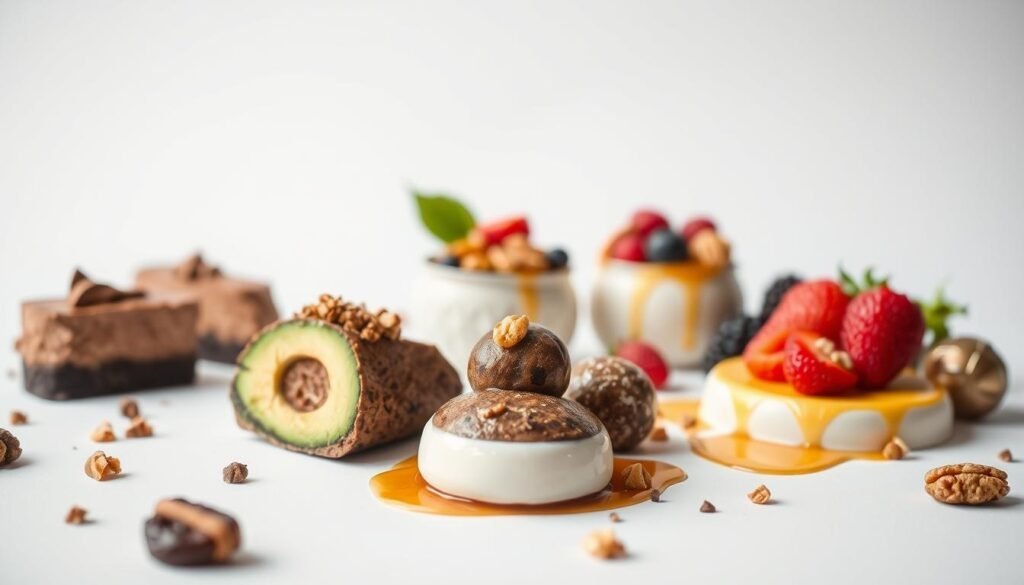Disclosure: This Post Contains Affiliate Links; We earn a commission on purchases.
Dietary restrictions are more common now. It’s important to make desserts for everyone. Knowing about different diets is key.
Customizing desserts means changing ingredients for diets like gluten-free, dairy-free, vegan, and low-sugar. By adapting recipes, everyone can enjoy their favorite sweets. This way, health and taste go hand in hand.
This method makes dining better for those with special diets. It also lets dessert makers get creative.
Key Takeaways
- Understanding dietary restrictions is key to creating inclusive desserts.
- Ingredient substitutions are important for adapting recipes.
- Customizing desserts can make dining better.
- Adapting recipes can lead to new dessert ideas.
- Desserts can be made for many dietary needs.
Understanding Common Dietary Restrictions
It’s important to know about dietary restrictions when making desserts. Many people have health needs or preferences that affect their diet. This includes lactose intolerance, celiac disease, veganism, and plant-based diets.
The NIH says 68% of the world can’t easily digest lactose. Celiac disease also affects many people, making gluten-free desserts a must. Veganism and plant-based diets are becoming more popular, too.
Gluten-Free Requirements and Celiac Considerations
People with celiac disease or gluten intolerance need gluten-free desserts. Gluten-free baking uses flours like almond or coconut instead of wheat. It’s key to bake in a gluten-free area to avoid contamination.
Dairy-Free and Lactose Intolerance Challenges
Those with lactose intolerance or dairy allergies need dairy-free desserts. Plant milks and vegan butters are good substitutes. They must be handled carefully to keep the right texture and taste.
Sugar Restrictions: Diabetic and Low-Carb Needs
For people with diabetes or on low-carb diets, sugar is a big deal. Natural sweeteners like honey and maple syrup can be used. They help make desserts that fit these dietary needs.
Vegan, Plant-Based, and Egg-Free Desserts
Vegan and plant-based diets don’t include animal products, like eggs and dairy. Egg substitutes like flax and aquafaba are used in vegan desserts. Making sure all ingredients are plant-based is important for these diets.
Essential Ingredient Substitutions for Dietary Needs
To make desserts for different diets, knowing what to swap is key. We change old ingredients for new ones that fit certain diets. This makes desserts safe and tasty for everyone.
Flour Alternatives: Almond, Coconut, and Gluten-Free Blends
Almond and coconut flour make desserts gluten-free. Gluten-free mixes, like rice flour and potato starch, are great too. Remember, swapping flour changes how things feel in your mouth.
- Almond flour gives a nutty taste and works well in soft treats.
- Coconut flour soaks up more liquid, so you might need to add more.
- Gluten-free mixes can replace regular flour 1:1, but adding xanthan gum helps with texture.
Dairy Substitutes: Plant Milks, Oils, and Vegan Butters
Plant milks and vegan butters are great for desserts. You can pick from almond, soy, coconut, or cashew milk. Think about the taste and feel you want in your dessert.
- Almond and soy milk are creamy and good for desserts.
- Coconut milk makes desserts rich and creamy.
- Vegan butters work like regular butter in most recipes.

Egg Replacements: Flax, Aquafaba, and Commercial Options
Flax and aquafaba are great for replacing eggs. Flaxseed mixed with water works in baked goods. Aquafaba whips up like egg whites and can replace eggs in many recipes.
- Flaxseed is full of omega-3s and fiber.
- Aquafaba is versatile and works in many desserts, like meringues and cakes.
Natural Sweeteners: Honey, Maple Syrup, and Sugar Alternatives
Honey and maple syrup are sweeteners that are better than sugar. Coconut and date sugar are other choices. But remember, they’re sweeter and taste different, so you might need to adjust your recipe.
Adjusting Recipes When Using Alternative Sweeteners
When you swap sugar for natural sweeteners, think about how sweet they are. Honey is sweeter than sugar, so use less. Also, liquid sweeteners change the liquid in your recipe.
- Honey adds flavor and moisture.
- Maple syrup has a strong taste and is best in desserts where it can shine.
How to Adapt Desserts for Dietary Needs: Techniques and Tips
Making desserts for different diets can be hard. But, with the right methods, it’s doable. It’s not just about swapping out ingredients. You need to know how they work together in a recipe.
Maintaining Texture and Structure in Modified Recipes
Changing a dessert’s texture and shape can be hard. For example, using flax or aquafaba instead of eggs can change how it holds together. Finding the right mix of substitutes helps keep the texture right.
- Use xanthan gum or guar gum to improve texture in gluten-free desserts.
- Replace eggs with appropriate substitutes like flaxseed or applesauce.
- Experiment with different types of flour to achieve the desired structure.
Balancing Flavors When Using Substitutes
Getting the flavors right is key when making desserts for different diets. Some substitutes, like almond milk or coconut oil, can change the taste. Adjusting spices, extracts, or sweeteners helps balance the flavors.
Tips for balancing flavors:
- Taste as you go and adjust seasonings as needed.
- Use natural sweeteners like honey or maple syrup to add depth.
- Experiment with extracts like vanilla or almond to enhance flavor.

Preventing Common Failures in Adapted Desserts
Common problems in adapted desserts include dense textures, strong flavors, or not setting right. Knowing how each ingredient works and how substitutes change things helps avoid these issues.
Too much liquid can make a dessert soggy, while too little can make it dry. Finding the right balance is key.
Cross-Contamination Prevention for Severe Allergies
For people with severe allergies, avoiding cross-contamination is critical. This means using separate tools, utensils, and areas for desserts that are safe for their allergies.
- Label ingredients clearly to avoid mix-ups.
- Clean surfaces thoroughly between preparations.
- Use dedicated equipment for allergen-friendly baking.
By using these techniques and tips, bakers can make special diet-friendly desserts that are tasty and safe. Whether for a vegan friend or someone with gluten intolerance, knowing how to adapt recipes is essential. This way, everyone can enjoy allergy-friendly desserts.
Popular Desserts Reimagined for Special Diets
Popular desserts like cookies and cakes can be made for different diets. You can use special ingredients to keep the taste and texture great. This way, everyone can enjoy their favorite sweets.
Classic Cookies and Brownies Made Allergen-Free
Make classic cookies and brownies safe for allergies. Use almond or coconut flour instead of regular flour. Also, use vegan butter or oil instead of regular butter.
Almond flour cookies are gluten-free and full of protein. They taste amazing.
- Use gluten-free flours like almond or coconut flour.
- Replace eggs with flax or aquafaba.
- Choose vegan butter or oil for dairy-free options.
Creamy Desserts Without Dairy: Puddings and Ice Creams
Make creamy desserts like puddings and ice creams without dairy. Use plant-based milks like almond, coconut, or oat milk. Coconut milk ice cream is a tasty dairy-free choice.
- Select a plant-based milk that suits your dietary needs.
- Use natural sweeteners like honey or maple syrup.
- Experiment with different flavors to enhance the taste.
Decadent Cakes and Pies with Dietary Modifications
Make decadent cakes and pies safe for special diets. Use different sweeteners and flours. For example, a gluten-free chocolate cake made with coconut sugar is both rich and diet-friendly.
No-Bake Options for Multiple Dietary Restrictions
No-bake desserts are perfect for many dietary needs. They can be made with nuts, seeds, and dairy-free chocolate. This way, they cater to different diets.

By reimagining desserts, people with dietary restrictions can enjoy many sweet treats. Whether it’s a classic cookie or a rich cake, there’s something for everyone.
Adapting Desserts for Diverse Dietary Needs
It’s important to make sure everyone can enjoy desserts, no matter their dietary needs. By knowing about common dietary restrictions, we can make sweet treats for all. We can use special ingredient swaps to make desserts for different needs.
Changing recipes for dietary needs is more than just swapping ingredients. It’s about knowing what each person needs and likes. We must keep the texture right, balance the flavors, and avoid mixing foods that shouldn’t be together.
With the right strategies, we can make popular desserts fit many dietary needs. This includes gluten-free, dairy-free, vegan, and low-carb options. It makes sure everyone can have their favorite desserts.
Trying new recipes and ingredients is fun and rewarding. It lets bakers be creative while making desserts for everyone. By adapting desserts, we make baking more fun and inclusive for all.
FAQ
What are some common dietary restrictions that need to be considered when adapting desserts?
How can I make gluten-free desserts?
What are some dairy substitutes that can be used in desserts?
How can I replace eggs in dessert recipes?
What are some natural sweeteners that can be used in place of refined sugar?
How can I prevent cross-contamination when adapting desserts for severe allergies?
Can I stil make decadent cakes and pies with dietary modifications?
Are there no-bake options available for multiple dietary restrictions?

From beginner-friendly tips to no-fuss dessert ideas, Ryan is all about helping people enjoy baking and treat-making without the stress. Whether you’re whipping up something for a party or just craving something sweet, Ryan’s practical approach makes it easy to create desserts that taste great and don’t take all day.
Subscribe to Our Newsletter







